I am attaching imges of the screen-printed ballet tutu, machine sewn together with text from my Royal Ballet and Elmhurst School reports!! Yikes!
Plus, the lead and aluminium tutu I created along with my aluminium pointe shoes – these were my Freeds shoes cast in aluminium and are unfinished but I loved the gnarliness of them. These were part of my Bachelor of Visual Arts final work for 2011, a study of ‘weight’ a mighty testy subject for ballet dancers!
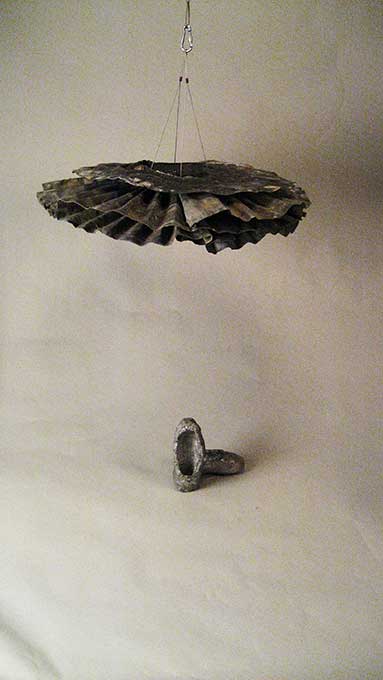
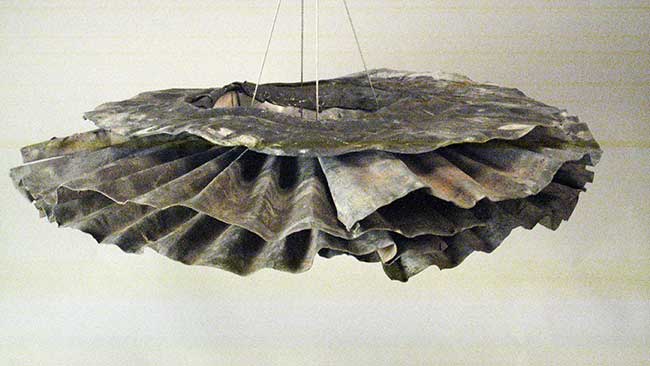

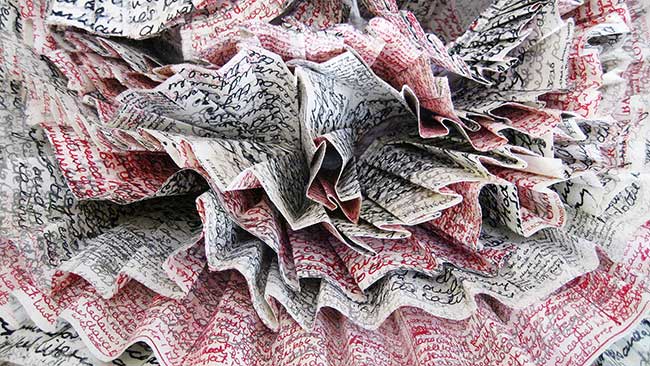
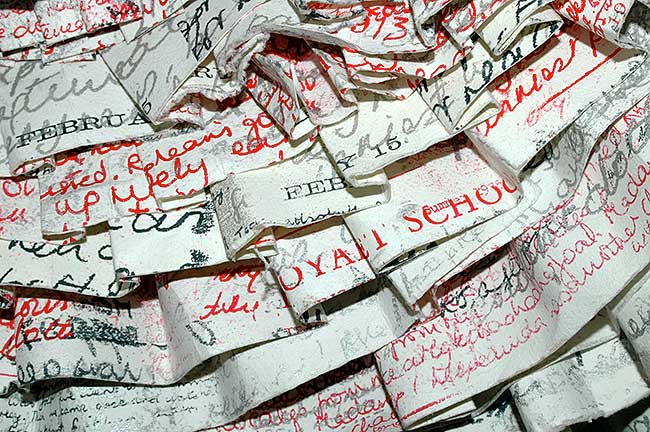
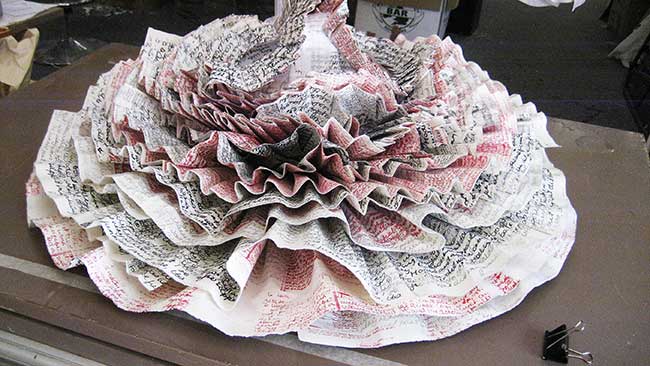
Requiem Ignotum (2011) amended
Requiem Ignotum is an installation about ballet, someone, and no-one.
It explores the realms of dance through sculpture and screen-printing, using autobiographical references. It questions the performative aspects of perfection, body weight, femininity, fragility, text, longevity, and memory. The lead and paper tutus assume
the role of a bizarre pas de deux, the former will remain intact for perpetuity whilst the latter in time dissolves and disappears mimicking the timeline of a dancer.
The scene is set as if on a theatre stage. The suspended ballet costume hangs mid-air as if lifted by an imaginary partner whilst the invisible dancer’s pointe shoes stay motionless appearing to need little prompting to pirouette or chainés to the next stanza of music. They appear as ‘objects out of action’. (Braddock. 2008:13)
The work questions density on many levels, the absurd fantasy of a tutu constructed of lead, (Pb 82), any form of movement would be impossible. The ironic use of lead to stand for the ballet tutu whose composition is lightness and femininity, here the lead resembles body armour. It also interrogates the irrational focus placed on the dancer’s body, trained, and contorted for the aesthetic standard aspired for ballet perfectionism. The lead tutu presupposes the immense weight, density of the dancer’s physical and mental psyche as their striving for ethereal weightlessness becomes the pinnacle of bodily perfection. “It is often said that dance is the creation of illusion: for example, the illusion of a weightless body”. (Sontag, 2003:191)
In opposition the malleability and composition of lead compliments the flexibility of the dancer and her steely resolve to overcome all. Lead for sculptor Anthony Gormley “brings silence and stillness, it is so inert, so dense, its greyness combines all colours”. (Gormley, 1984:12). The lead appears sewn, stitched with rivets such as in a tulle tutu, with the top layer screen-printed in silver text, entrants from my childhood diary, when training to be a ballet dancer. The metal brings a funereal aspect to the work because of its association with death and burial, and death as in the termination of a dancer’s career. Modern dancer Martha Graham laments, “a dancer, more than any other human being, dies two deaths: the first, the physical when the powerfully trained body will no longer respond as you would wish … without dancing, I wished to die”. (Graham, 1991:238)
The accompanying pointe shoes cast in aluminium are a play on weight and density, it would be impossible to dance in such creations, yet they imbue the identity of their original satin slippers and invent the possibility that the dancer may have momentarily slipped out of them. The lead tutu and aluminium pointe shoes together assume a performative illusion all their own, frozen in time, waiting for the dancer’s body to slide into the belly of the costume and for the performance to begin.
The screen-printed hahnemuhle paper tutu is created in the same way an actual tutu is constructed and sewn, with 24 paper frills of various dimensions (54-75 inches long) and widths 13 by 1.5 inches, each individually screen-printed and stitched by a sewing machine. The tutu signifies my early dreams and ideals as a young dancer, screen-printed journal ramblings appropriated to assume the materiality of the dancer’s skirt. The original pages of my 5-year diary and school reports from Elmhurst & the Royal Ballet Schools, create the wave and pattern of a new fabric. The colours of ink are a theme, red symbolises the emotion and blood of the dancer, paynes grey her steely attitude and strength, and silver for femininity, and theatricality, mirroring the chemical elements.
The process of creating this body of work required endless toil not unlike the ritual of the daily ballet class, rehearsals, performance, repetition to reveal a result – performance versus artwork. Anselm Kiefer refers to personal experience being intrinsic to his arts practice, “he cannot abide an art form which, he imagines lacks the powerful impulse of life experience”. (Rosenthal, 1987:10).
This work embodies such.
Notes
Auckland University of Technology, 2008.
Braddock, Christopher Gregory. “The artist will be present: performing partial objects and subjects.” PhD diss.,
Graham, Martha. Blood Memory: An Autobiography, Doubleday: New York, 1991.
Rosenthal, M. Anselm Kiefer, Chicago Philadelphia, Presvel-Verlag, 1987.
Salvatore Ala, Anthony Gormley, Coracle Press: London, 1984.
Sontag, Susan. Where the Stress Falls, Vintage: London, 2003.
Sonia York-Pryce, Dr Visual Arts
https://soniayork-pryce.wixsite.com/mysite
Toucher Légèrment: or how to print an etching through dance.
https://vimeo.com/manage/videos/46432756

Marvelous
Comment by Claire Victor on 30 October, 2023 at 1:44 pm